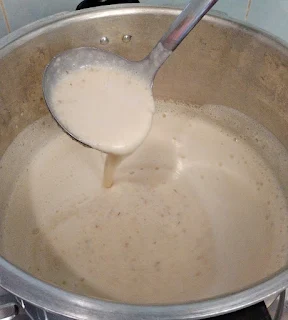Ginkgo Bean Curd and Barley Sugar dessert (白果腐竹薏米糖水)
Do you miss this delicacy of Ginkgo
Bean Curd and Barley Sugar dessert? When did you most recently enjoy or make
it?
Ginkgo, commonly known as ginkgo. It
is very popular when used to cook bean curd sheets. I went to a dessert house two
days ago. The waitress was serving this dessert to a young lady who was sitting
next to me. I overheard that lady comment about that dessert is different from other
dessert houses.
So, I give it a go. I am not sure how
it was different from other dessert houses. But it is different from what I had
before. It is creamy, smooth, and rich in flavour. So, I am going to copycat this,
and my family loves it so much. Especially youngsters who do not like any small
chunks to chew on with liquid dessert.
This dessert can be cooked on the
stove or pressure cooker. There's a catch, though: Yuba sheets or bean curd
sheet, also known as Fu Chuk, come in a variety of forms. If you opt for making this dessert over a
stove, need to choose the kind that dissolves easily after cooking for an hour
or two. The thick, firm type is usually used in the preparation of savoury
foods. The softer, thinner type is what you are looking for.
I am making this dessert with a pressure
cooker, so I literally put all the ingredients into the pot and let it cook for
10 minutes. My barley all turned soft, and the bean curd sheets totally breakdown.
I like to use the type with the shell
on for the ginkgo. Deshelling it and extracting the ginkgo nut core will
therefore take some time. You may use the type that has already been deshelled
from the fresh food store.
I'm blending the barley using an
immersion blender. You'll see that the
liquid has now turned creamy and smooth. For the same reason, a standard fruit
blender can be used.
INGREDIENTS
1 little of water
100g pearly barley
1 pack dry bean curd sheets
100g ginkgo
80g rock sugar or to your taste
3 pandan leaves (tie into a knot)
2 eggs
METHODS
1. Crushed the dry bean curd sheet in the plastic.
2. Deshell the ginkgo and peel the
ginkgo’s outer membrane. Cut into half and remove the core of the ginkgo nuts.
Wash and strain, keep aside.
3. Rinse the pearl barley under running
water, filter and keep aside.
4. In a pressure cooker, bring the
water to a boil. Add all the ingredients to the pot. After it boils, cover the
lid. Wait until the steam release valve starts spinning. Set the timer to cook
for 10 minutes at high heat and then let it naturally release steam.
OR
4. If you cook it on the stove, after
it boils, reduce the heat to medium-low and simmer for two hours.
5. Carefully unlock the lid. You will
see that the bean curd sheets totally broke down, the liquid also turned to
milky colour, and the barley all turn soft. Use an immersion blender to blend
the barley until creamy. Taste and
adjust with more sugar if necessary.
Note: Remove the ginkgo before blending
the mixture and then add it back.
6. Using a fork, beat two eggs, then
gently pour into it, stirring as you go. Serve it warm.







Comments
Post a Comment